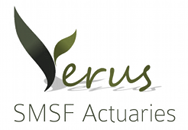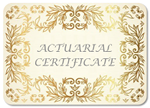When Do You Need an Actuarial Certificate?
1. Introduction
This article discusses the circumstances in which you are required to obtain an actuarial certificate for a Self Managed Superannuation Fund.
2. Account Based Pensions
If your SMSF has one or more retirement phase account based pensions (including allocated pensions, market linked pensions, or retirement phase transition to retirement income streams), you may need an actuarial certificate. The actuarial certificate provides the percentage of the Fund’s investment income (from unsegregated assets) that is exempt from tax under Section 295-390 of the Income Tax Assessment Act.
2.1. General Principles
You will need an actuarial certificate for your SMSF if, during the financial year, the SMSF was partly in retirement phase and partly in non-retirement phase, unless you have fully segregated the SMSF's retirement phase assets from its non-retirement phase assets.
This means you won’t need an actuarial
certificate if:
-
The SMSF was entirely in non-retirement phase for the whole of the year (in which case all the investment income will typically be taxable); or
-
The SMSF was entirely in retirement phase for the whole of the year (in which case all the investment income will typically be tax exempt); or
-
All of the SMSF’s retirement phase assets were segregated from all of the SMSF’s non-retirement phase assets throughout the year.
The sections below provide more details.
2.2. Disregarded Small Fund Assets
To help understand when you may need an actuarial certificate, it is useful to first explain an important related concept: disregarded small fund assets.
A Fund will have disregarded small fund assets if, just before the start of the tax year:
-
One or more of the members in the Fund has a total superannuation balance of more than $1.6m (including all of the member’s superannuation entitlements, not just those in this Fund); and
-
That member was receiving a retirement phase superannuation income stream (in any fund); and
-
(From the 2021/22 tax year) The Fund is not entirely in retirement phase at all times during the year.
You need to know whether or not your Fund meets this definition, because if your Fund has disregarded small fund assets, you are only able to use the proportionate method to calculate the Fund’s Exempt Current Pension Income (ECPI). The methods for calculating ECPI are explained further in the section 2.3, below.
2.3. Methods of Calculating Exempt Current Pension Income
There are two main methods for calculating a Fund’s Exempt Current Pension Income (ECPI). These are often referred to as the proportionate method and the deemed segregation method.
Also note that the discussion below is most relevant for the 2021/22 and more recent tax years. For older tax years, some of the rules were different. We have included some brief comments about older tax years later in this article.
a) Using the Proportionate Method
One method for calculating ECPI is known as the proportionate method. This method is used when the Fund does not segregate its retirement phase assets from its non-retirement phase assets. This method is also sometimes referred to as the unsegregated method.
This method calculates the tax exempt percentage based on the proportion of the Fund’s total liabilities that are pension liabilities. The proportion is averaged across the financial year, then applied to the Fund’s investment income to determine the ECPI amount.
Using the proportionate method is the usual option for calculating ECPI if:
-
Your Fund has disregarded small fund assets; or
-
There is no point during the year when your Fund is entirely in retirement phase.
If you are using the proportionate method for calculating ECPI, you will need an actuarial certificate.
If your Fund does not have disregarded small fund assets, and there are time(s) during the year when the Fund is entirely in retirement phase, you can choose whether to use the proportionate method or to use the deemed segregation method (described in the next section) for calculating ECPI.
b) Deemed Segregation Method
If at any time(s) during the year, a Fund is entirely in retirement phase, that Fund’s assets may be deemed to be segregated. During these periods, the Fund’s assets will be deemed to be segregated unless:
-
The Fund has disregarded small fund assets; or
-
The trustee(s) have chosen to use the proportionate method for calculating ECPI.
That is, if there are any time(s) during the year when a Fund is entirely in retirement phase, and the Fund does not have disregarded small fund assets, you can choose to use the proportionate method or the deemed segregation method for calculating ECPI.
If you choose to use the deemed segregation method, then during periods when the Fund is deemed to be segregated, the Fund’s investment income would typically be entirely tax exempt, and no actuarial certificate is required in respect of those periods.
If you are choosing to use the deemed segregation method for calculating ECPI, you may need an actuarial certificate for the rest of the year. Whether or not you need an actuarial certificate depends on the circumstances in the parts of the year when your Fund is
not entirely in retirement phase:
-
You will not need an actuarial certificate if, for the rest of the year, the Fund is entirely in non-retirement phase.
-
You will need an actuarial certificate otherwise. That is, you will need an actuarial certificate if there are any retirement phase balances at any times while the Fund is not entirely in retirement phase. In this case, the tax exempt percentage in the actuarial certificate will apply just to the periods when the Fund is not deemed to be segregated, and to the investment income earned during those period(s). The calculation of the tax exempt percentage will be based on the average proportion of the Fund’s total liabilities that are pension liabilities, during those particular period(s).
2.4. Other Considerations
a) 2020/21 and Older Tax Years
For the 2020/21 and older tax years, some of the rules relating to ECPI and actuarial certificates were different.
For the tax years from 2017/18 to 2020/21, Funds were not able to choose whether to use the proportionate method or the deemed segregation method. This means that if your Fund had any period(s) during which it was entirely in retirement phase (and it did not have disregarded small fund assets), then it must use the deemed segregation method.
It was also the case during the tax years from 2017/18 to 2020/21, that for a Fund that had disregarded small fund assets, an actuarial certificate was required even if it was entirely in retirement phase for the whole of the tax year.
For the 2016/17 and older tax years, the ATO’s view is that Funds were not able to choose whether to use the proportionate method or the deemed segregation method. However, they have acknowledged that permitting that choice had been long-standing industry practice, and have indicated that
they do not intend to review Fund’s ECPI calculations from those years, in relation to the choice of method.
b) Elected Segregation
Sometimes trustees may elect to segregate one part of a Fund’s assets from another part of a Fund’s assets. (While the terminology is similar, elected segregation is not entirely the same as the deemed segregation discussed earlier).
The discussion and information in this article does not cover the topic of elected segregation. If you would like to know more about elected segregation, please contact us.
c) Small or Negative Taxable Income
You will not need an actuarial certificate if the SMSF’s taxable investment income was negative during the year. However, note that for this purpose taxable income excludes realised capital losses in excess of any realised capital gains. Realised capital losses will not (on their own) make an SMSF’s taxable income negative because they can only be offset against realised capital gains.
If your SMSF has a small but positive taxable investment income during the year, consider whether the benefit of the tax exemption will exceed the cost of the actuarial certificate – if you would only be paying very small amounts in extra tax, it may not be worth getting one.
d) Timing for Actuarial Certificates
If you need an actuarial certificate for an SMSF with account based pensions, you should arrange it after the end of the tax year, but before the due date for the Fund’s tax return.
3. Defined Benefit Pensions
If your SMSF has one or more defined benefit pensions, then superannuation law requires that you obtain an actuarial certificate every year. There are several different types of defined benefit pensions, including complying lifetime, complying term and flexi pensions.
If you need an actuarial certificate for an SMSF with defined benefit pensions, you should arrange it after the end of the tax year, but before you submit the Fund’s tax return. If your defined benefit pension is treated as fully or partially Assets Test Exempt for Centrelink purposes, Centrelink also requires that a copy of the actuarial certificate is provided to them before 31st December after the end of the tax year.
For SMSFs with defined benefit pensions, the actuarial certificate provides the percentage of the Fund’s investment income that is exempt from tax under Section 295-390 of the Income Tax Assessment Act. It also provides an opinion regarding whether there is a high probability that the Fund’s assets will be sufficient to pay the defined benefit pensions (this is sometimes referred to as the “adequacy opinion” or “high probability test”).
The information provided in this document is not financial product advice. It does not take into account your specific circumstances or needs. While Verus SMSF Actuaries has taken care to ensure that the information is accurate, you should seek appropriate professional advice before acting on any of the information provided.
Updated November 2024








